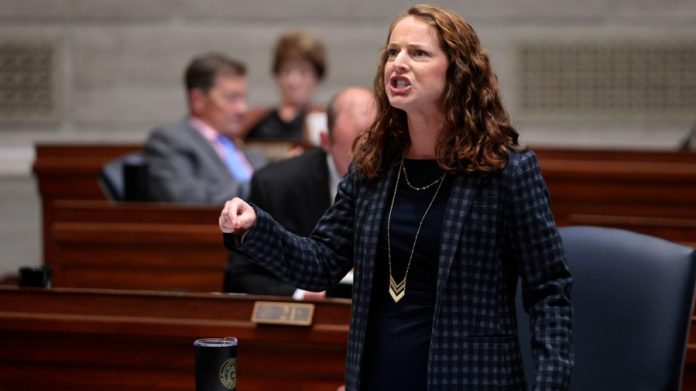
Missouri Democrats see turning to the public as the best way to stop a new GOP-friendly congressional map from taking effect despite their minority status in the state legislature.
Gov. Mike Kehoe (R) is poised to sign the new map into law for the 2026 midterms after the state Senate gave approval on Friday. The map would likely give Republicans one additional seat in the House as the GOP tries to hold its narrow majority, taking out a current Democratic House member.
But Democrats may be able to send the issue to Missouri voters as a veto referendum for them to decide whether the map should be used.
Here’s what to know:
How it would work
Democrats legislatively didn’t have many options to stop the map other than temporary stalling tactics. But the vote margins that the map received in the legislature can determine whether they have another chance to stop it.
Missouri law has a mechanism for voters to effectively veto legislation passed by lawmakers by gathering support to force a statewide vote.
The legislation for the new map passed this week didn’t include a so-called emergency clause, which would have made the bill effective as soon as the governor signs it, local outlets reported. Despite the Republican dominance in both chambers of the legislature, the threshold for approving the emergency clause is higher than the number of seats the GOP has in the state House.
Now, Democrats and other opponents will have 90 days after the map is signed to collect enough signatures — five percent of voters in each of two-thirds of the state’s congressional districts — to order a referendum, according to the Missouri Secretary of State’s rules.
If enough signatures are gathered, an election would be held and the public’s vote would decide the map’s fate.
“I think that’s kind of the Democrats’ best bet at this point, that they’ll be able to use the referendum to beat it back,” said Greg Vonnahme, a political science professor at the University of Missouri-Kansas City.
The Missouri Democratic Party declared its support for a referendum following the state Senate’s vote.
“They don’t care about the will of the people, or about protecting our voice in government,” said state party Chair Russ Carnahan about those who voted for the map. “Now it’s up to us to do what they won’t.”
The nonpartisan coalition People NOT Politicians – Missouri formally filed a referendum petition with the Missouri Secretary of State’s office on Friday, starting the process of gathering signatures.
Protests, polling signal opposition
Big crowds have reportedly gathered at the Missouri Capitol this week as thousands protested the redistricting plan, signaling a vocal opposition in the Show Me State as observers wonder whether a referendum push could get the support it would need.
Polling is sparse, but a Change Research survey commissioned by the Democrats’ House campaign arm at the end of August, as shared by Politico, found 48 percent of Missouri voters oppose the redrawing. Another 37 percent supported it, with 19 percent undecided.
Chris Melody Fields Figueredo, the executive director of the Ballot Initiative Strategy Center, said the protests suggest people are energized to oppose the map and opponents are in a strong position to block it through the referendum process. The progressive organization works to use ballot measures to strengthen democracy, draw attention to marginalized communities and advance racial equity, according to its website.
“We’ve had thousands of people at the state capitol speaking out against this illegal gerrymander,” she said, adding that groups have a long history of using the initiative and referendum process to ensure that Missourians’ voices are heard.
But Dan Butler, a political science professor at Washington University in St. Louis, Mo., suggested that it may not be in Democrats’ best political interest to push forward with a referendum.
“When voters go to the polls, maybe there are people who normally vote Republican, but they’re upset about this district map. They want to send a message. If there’s not a referendum … they’ll vote against the Republicans, in favor of Democrats,” Butler said.
“But if now they can vote both against this redistricting plan and still vote Republican, it actually, I think, ironically — potentially, it protects Republicans from some of the blowback they might get otherwise.”
Voters used referendum to reject law in 2018
Precedent exists for this type of process in the Show Me State to overturn actions from the legislature.
Missouri voters have frequently turned to ballot measures in recent years, legalizing recreational marijuana and protecting abortion rights in the last two cycles, but experts say the referendum process is rarer.
“Missouri is pretty active in its initiative use. But … we really don’t see the popular referendum used that much at all,” Vonnahme said.
Still, voters last used a referendum in 2018 to reject a right-to-work law that passed through the GOP-controlled Legislature. Labor advocates submitted roughly three times the signatures they needed to set up a statewide ballot vote, then rejected the law by a 2-to-1 margin.
“Grassroots organizations should use any opportunity available to them to defend direct democracy that has been widely popular in the state,” Figueredo said.
Targeted Democrat promises legal fight
Republicans control six of eight districts in the Show Me State, and the new maps would dramatically reshape Rep. Emmanuel Cleaver’s 5th Congressional District in Kansas City to help Republicans net a new seat.
After the Missouri House approved the maps this week, Cleaver called it “deeply disappointing” that legislators had “put the demands of DC power brokers ahead of the wishes of Missouri families in yet another partisan power grab.”
Cleaver, who has been in Congress for two decades, won reelection with 60 percent of the vote last fall, after line changes in 2022.
The Associated Press reported that Cleaver plans to challenge the new map in court –- and run for reelection next year, no matter what his district looks like.
“I think for opponents, the only shot is legal challenge, or this referendum avenue,” said David Kimball, a political scientist at the University of Missouri-St. Louis.
Suzan DelBene, chair of the Democrats’ House campaign arm, said “all options” are on the table.
“Missourians hate Republicans’ plot to gerrymander the state. The voters have pushed back to stop state Republicans from their past attempts to ignore the will of the people, and all options, including legal action and the referendum process, are on the table to ensure fair maps,” DelBene said in a statement after the state Legislature approved the maps.

